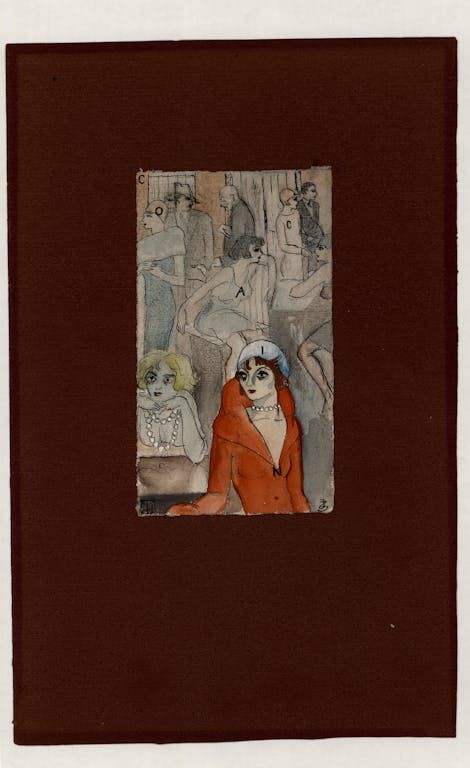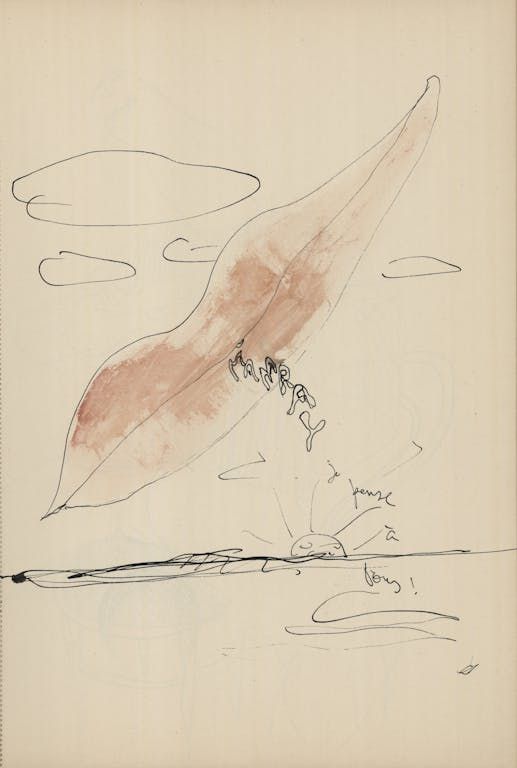For the 100th anniversary of the Surrealism Manifesto, the Museum of Art and History is presenting never-before-seen drawings by the Basel artist.
Irène Zurkinden, The vicious circle: split! (1932-1939) © Estate Irène Zurkinden/MAH
Published on 06/21/2024
Estimated reading time: 4 minutes
“These are truly works to discover.” In the three small rooms dedicated to graphic arts, at the Geneva Museum of Art and History (MAH), the soberly titled exhibition Irene Zurkinden (1909-1987) presents a largely unpublished corpus, according to Marie-Eve Celio-Scheurer. In this centenary year of the Surrealist Manifesto, the artist is presented here from the angle of her Parisian years, between 1929 and 1939, in contact with the movement theorized by the poet André Breton, explains the curator, responsible for the field of graphic arts at MAH. The display includes around fifty drawings, two paintings and four notebooks – digitized, they can be flipped through on e-readers – works from the artist’s estate (estate). A recently discovered archive which allows us to offer a new approach to one of the best-known movements of the last century, influenced by dreams, chance or automatism.
Daughter of a dance teacher and a customs officer, teenager Irène Zurkinden is fond of drawing and imagines a future in fashion. She enrolled at the Basel School of Arts and Crafts, before completing her training in Paris, at the Académie de la Grande Chaumière, thanks to a scholarship from the canton of Fribourg, where her father came from. She immersed herself in the life of Montparnasse and rubbed shoulders with the surrealist avant-garde, residing for a time with Meret Oppenheim, a fellow artist with whom she exchanged throughout her life. And in whose shadow she will practice her art, without benefiting from comparable recognition.
“She remained independent all her life, not locking herself into any movement”
Marie-Eve Celio-Scheurer
One room of the exhibition recounts this Parisian life, with drawings including the friend Oppenheim or personalities like Alice Prin, alias Kiki de Montparnasse, the model that Man Ray immortalized as a cello, with two soundholes in the back. The artist paints the emblematic photographer, while, conversely, Man Ray takes the portrait of Irène Zurkinden (a photo to be seen at the Center Pompidou). The mundane face of life on the Left Bank, a gouache presents several female characters with heavily circled eyes, while six letters wander through the work – it is COCAIN (around 1929).

The adjacent space presents what Irène Zurkinden has kept from surrealism. We see more or less recognizable references to Salvador Dalí, or to the organic forms of Max Ernst. “And undoubtedly also to surrealist exhibitions hung during these years in Paris,” explains Marie-Eve Celio-Scheurer, who points out certain incongruous contours in the drawings. We will know more when an in-depth examination of this corpus has been carried out.
The third room focuses on the intimate, from friendships to solitary pleasures, including the representation of a phallus tree on legs and high heels. A large, naked and rather crude self-portrait demonstrates the artist’s avant-garde character: “For a woman, it was not at all usual to represent herself in this way.” Several drawings also show her companion, the German-Brazilian jazzman Kurt Fenster, with whom she had two sons.

Returning to Switzerland at the start of the Second World War, Irène Zurkinden made her living creating costumes and sets for the theater, as well as post-impressionist style paintings, sold to the Basel bourgeoisie. “She remained independent all her life, not locking herself into any movement,” estimates Marie-Eve Celio-Scheurer.
Also in Lausanne
At the same time, the artist continues to draw in her notebooks, “where she keeps her fervor and her original strength”. She asked her family not to reveal this body of work immediately after her death – it would ultimately remain unpublished for many decades. And benefits from another news at the moment: several drawings and paintings of the estate are exhibited in Surrealism. The big gameat the MCBA in Lausanne.
The exhibition is part of a wider research project, with publication planned for May 2025; and an update of information relating to surrealist works on paper from the MAH (produced between 1918 and 1948), produced with students from the Institute of Art History and Museology at the University of Neuchâtel – a catalog will be published online next November.
>Le CourrierGeneva Museum of Art and History, until September 29.






